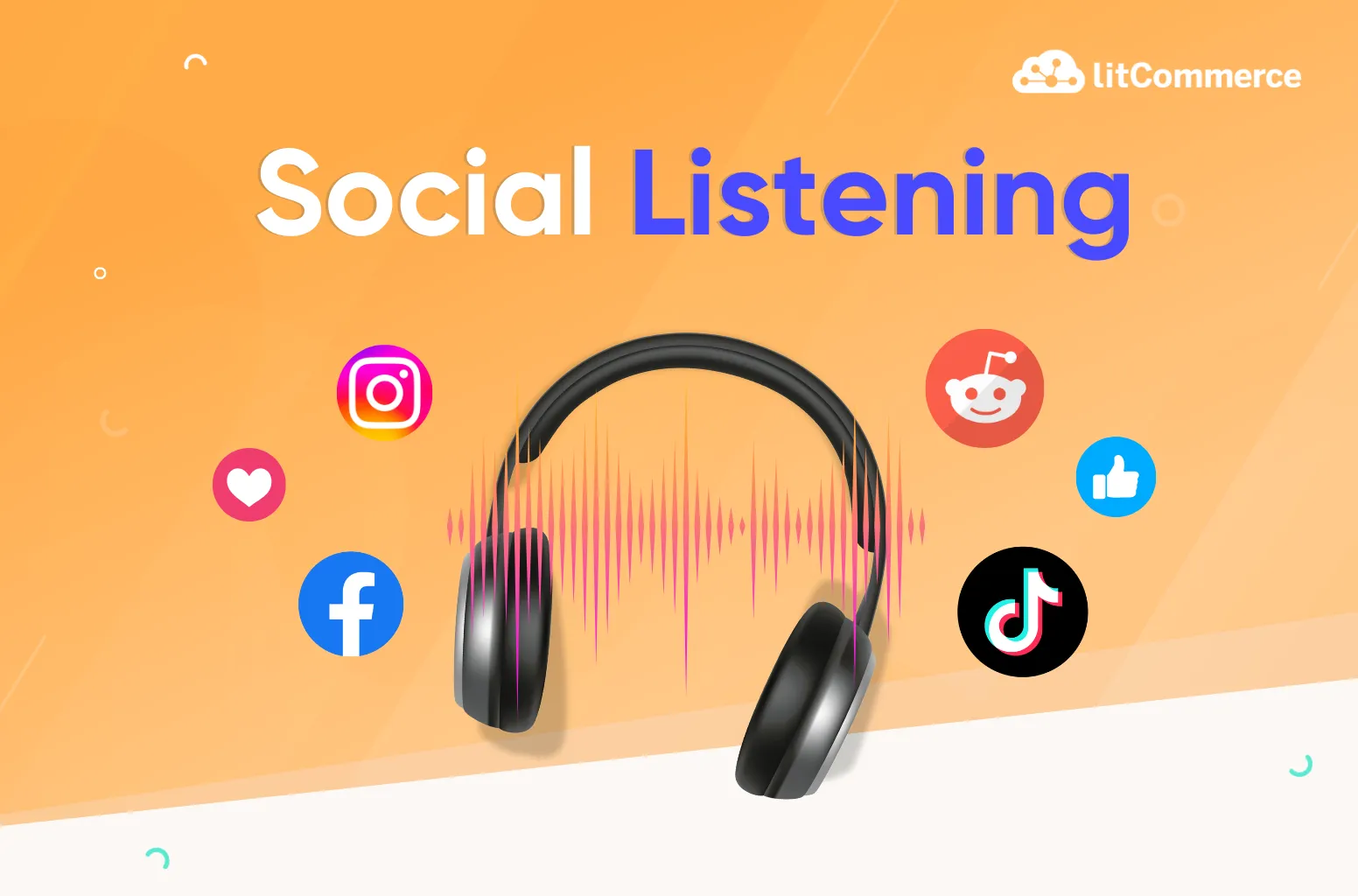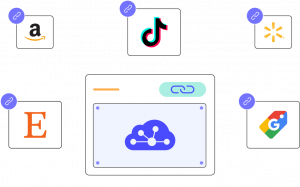Many marketers often focus so heavily on creating engaging content that they forget to stay in tune with the broader conversations happening around their brand. The result? A single negative review or viral complaint can damage your brand reputation, and hurt customer retention, all before you even realize it’s happening. If that sounds familiar, it’s time to start paying attention to social listening.
Social listening is an essential tool for modern marketers navigating a digital world where electronic word of mouth (eWOM) can spread in seconds. It helps you track, interpret, and act on what people are really saying about your brand.
So what exactly is social listening definition, how does it work, and what are the real benefits? How do you build a strategy that works, and which tools should you use? This article will walk you through everything; so by the end, you’ll know how to listen smarter, respond faster, and build stronger brand trust.
What is Social Listening?
Social listening is the active process of attending to, observing, interpreting, and responding to a variety of stimuli through mediated, electronic, and social channels like:
- X
- TikTok
- YouTube
- Discussion forums like Reddit, Quora
- Blogs
- Consumer review sites
- and more
At its core, social listening is about actively understanding the context, sentiment, and conversations that shape public perception, even when your brand isn’t directly tagged. It combines technology and human insight to extract meaning from the noise.
Here are some examples of social listening in action:
- A skincare brand tracks mentions of “dry skin” and “eczema” on TikTok and identifies a common concern: people want fragrance-free formulas.
- A fast-food chain notices a spike in negative tweets about undercooked items in one region, then investigates and quickly resolves a supply chain issue.
- A fashion brand sees customers talking about “coastal cowgirl” on Instagram and Pinterest, then launches a micro-campaign with that theme.
And below is an infographic about how social listening works:
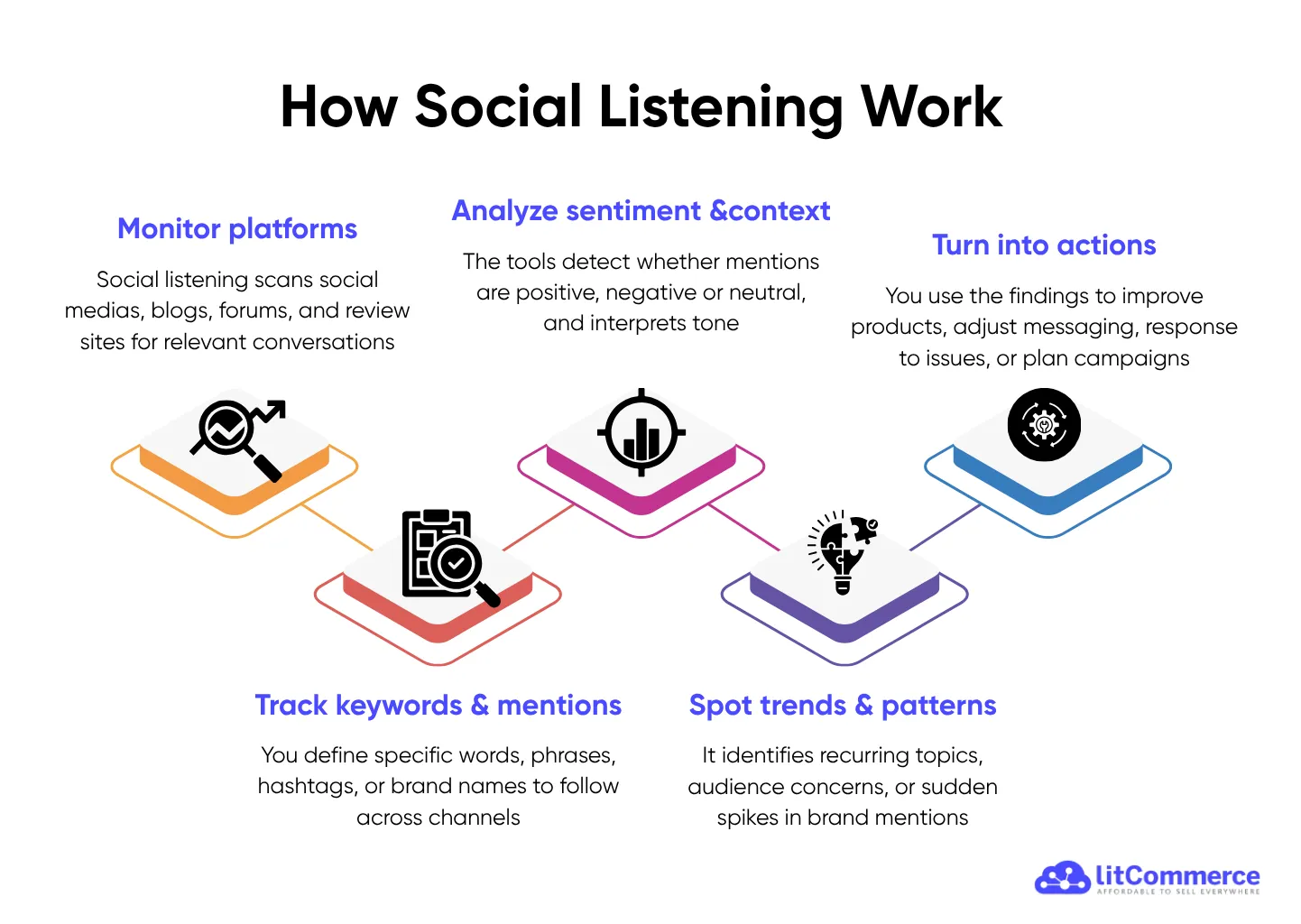
What’s more, AI is rising as a notable trend in social listening. It no longer just classifies comments as positive or negative. It can now interpret tone, sarcasm, emojis, cultural context, and emotional nuances, hence, correctly spot feelings like anger, happiness, or confusion. Thanks to this, you can step in quickly and correctly, instead of making the mistake of saying thank you for what was actually a complaint.
Social Listening vs. Social Monitoring
Social listening and social monitoring are often misunderstood; however, these two concepts have distinct activities and benefits.
Social monitoring is all about tracking and collecting surface-level data such as counting brand mentions, likes, shares, tags, comments, or specific keywords across platforms. It helps you stay informed about what’s being said and when, but it stops at observation.
In contrast, social listening digs deeper. It not only tracks these conversations but also analyzes the sentiment, trends, motivations, and context behind them. Social listening asks bigger questions: Why are people saying this? What patterns are emerging? What actions should we take?
You can think of it like this:
- Monitoring = “What is being said?”
- Listening = “Why is it being said and what should we do about it?”
You may also like: What is Personal Branding And Why Is It Important (2025 Trends & Tips)
5 Key Benefits of Social Listening
Social listening is not as simple as the word “listen” might suggest. It goes far beyond just hearing your brand’s name pop up online.
When done right, social listening unlocks a wealth of insights that can transform how you market, support customers, and build stronger relationships. It helps you move from reacting to truly anticipating your audience’s needs and behaviors.
Big brands like Netflix, Nike, and Starbucks have long used social listening to shape product decisions, catch PR issues early, and even launch viral campaigns at just the right moment. And your business could also gain benefits from social listening in a similar manner.
Here are five key benefits of social listening to your business:
1. Understand your brand health
Brand awareness shapes your brand’s success and social listening helps you track it in real time. By monitoring both praise and criticism, you’ll uncover what resonates and what needs fixing.
According to The Social Intelligence Lab, social listening is a factor in every decision for 30% of agency professionals. When done right, social listening unlocks a wealth of insights that can transform how you market, support customers, and build stronger relationships. It helps you move from reacting to truly anticipating your audience’s needs and behaviors.
These insights often challenge internal assumptions and reveal how your audience truly sees you. Some brands use listening to track customer love and shape campaigns accordingly. Negative feedback is just as valuable and it can expose deeper issues in your service or product. Even positive mentions offer a gut check to confirm you’re on the right path and targeting the right audience.
2. Know your audience’s needs
Understanding what your audience wants starts with listening to what they’re saying. Social listening reveals common questions, frustrations, preferences, and goals directly from the source. It helps you identify what matters most to different customer segments so you can tailor your messaging, offers, and product features.
For example, if you notice frequent mentions of confusion around subscription billing, that’s a signal to simplify your pricing page or create a clear FAQ. When you know your audience’s needs, you stop guessing and start serving. This not only builds stronger loyalty but also creates content that actually converts. The better you listen, the better you connect.

3. Spot industry trends and shifts early
Social listening also helps you detect emerging trends before they go mainstream. By tracking key conversations, hashtags, and competitor mentions, you can spot market shifts, tech disruptions, or evolving customer expectations.
It’s also a great way to find content gaps or unmet needs your brand could fill. You can monitor what’s working for your competitors, then adapt or improve on their strategies. For example, on platforms bombarded with fast-moving trends like TikTok, social listening helps you reveal these trends that traditional tools often miss.
4. Improve customer service and satisfaction
Your customers are already talking about their experience, and social listening helps you catch those conversations in real time so you can respond quickly and meaningfully. Whether it’s a product issue, shipping delay, or rave review, these insights let you act before problems grow. By spotting recurring questions or complaints, you can build proactive support content or improve internal processes.
Quick, public responses also show your audience you care and are paying attention. Over time, this builds trust and increases satisfaction – two key drivers of customer loyalty. In fact, 83% of customers agree that they feel more loyal to brands who respond to and resolve their complaints.
5. Manage crises before they escalate
When something starts to go wrong (a customer complaint gaining traction, a PR issue brewing, etc.) listening tools alert you before it snowballs. This gives your team a chance to respond quickly, address the issue, and control the narrative. Instead of being blindsided, you can prepare talking points, coordinate internal teams, and show transparency to your audience.
Speed is critical in crisis management, and listening gives you that speed. It also helps you learn from every situation to prevent repeat problems in the future. In a world where one post can go viral fast, real-time listening is a must.
How to Build a Strong Social Listening Strategy (6 Steps)
To build a strong social listening strategy, you need to answer:
- What are your specific listening objectives?
- Which social listening tool best suits your requirements?
- What particular information do you intend to monitor?
- Which channels should you focus your listening efforts on?
- How will you effectively analyze the gathered data?
- What actions will you take based on the insights you gain?
Now, let’s explore the answer for each question on how to use social listening.
Step 1: Define your listening goals
Social listening can support a wide range of business goals, from improving customer service to identifying new product opportunities. But without a clear purpose, the amount of data collected can quickly become overwhelming and directionless.
To use social listening effectively, you need to start with a clear objective. Ask yourself: What do I want to learn from these conversations? This will guide what you track, which platforms you monitor, and how you respond to insights.
- Brand reputation management: Monitor how customers talk about your brand.
- Customer service improvement: Identify complaints, questions, and feedback in real time.
- Competitor analysis: Track what people are saying about competing brands.
- Product development: Use social listening to learn what features they want, what frustrates them, and what they love.
- Campaign performance: Measure how audiences react to your campaigns based on sentiment, mentions, and engagement.
- Trend detection: Spot emerging topics, memes, and conversations.
- Influencer discovery: Find creators and advocates who already talk about your industry or brand.
Stay focused by employing SMART goals (specific, measurable, achievable, relevant, and time-bound). For example, “Boost weekly brand mentions by 15% over the next 60 days by engaging in trending conversations and sharing two social posts per week inspired by listening insights”.
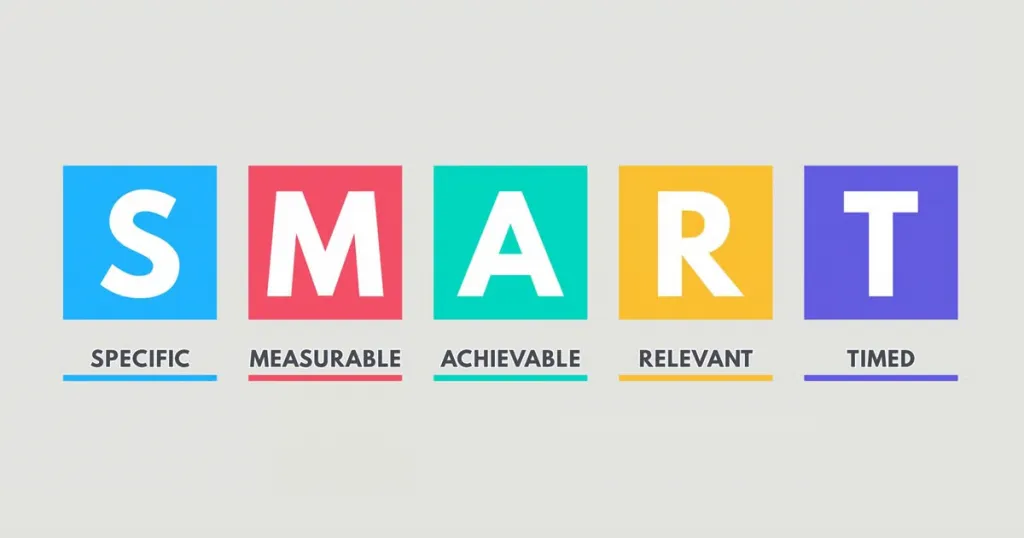
Step 2: Select the right tools
Analyzing thousands of online messages by hand seems not practical, and developing a specialized social listening tool requires tons of time and financial investment.
Hence, to execute your social listening plan effectively, it’s recommended that you use a tool capable of collecting data from various platforms, while also offering real-time alerts, sentiment analysis, and customizable dashboards.
Key features to looking for in an advanced social listening tool:
- Multichannel coverage: Monitor discussions across social media, review sites, blogs, forums, podcasts, video platforms, etc.
- Real-time monitoring: Track brand mentions across multi platforms.
- Sentiment analysis: Automatically detect whether conversations are positive, negative, or neutral to understand audience mood at scale.
- AI-powered topic & theme detection: Use AI to uncover recurring themes, emerging topics, and hidden patterns in large volumes of conversations.
- Keyword & boolean search: Set up precise search queries to monitor specific topics, competitors, campaigns, or customer issues.
- Competitive benchmarking: Analyze how your brand stacks up against competitors in terms of mentions, sentiment, share of voice, and engagement.
- Custom reporting: Create shareable dashboards with real-time data, visualizations,
Popular social listening tools that cover these essential features you can opt for:
- Sprout Social: Great for analytics and customer care
- HubSpot: Best for integrating social media listening with CRM
- Later: Great for Instagram and visual content tracking
- Hootsuite: Good for all-in-one social management
- Brandwatch: Powerful for enterprise-level insights
Choose a tool that fits your budget, goals, and team size, and make sure it covers the platforms your audience actually uses. With the right tool, social listening becomes actionable, not overwhelming.
In the upcoming section, we’ll dig deeper into these social listening tools comparison, so that you can easily find which best fits your needs.
Step 3: Choose what to listen for
Once you’ve defined your listening goals, the next step is choosing the right tools to help you monitor relevant conversations effectively.
Start by outlining the keywords, phrases, hashtags, and topics that align with your goal.
For example, if your goal is reputation monitoring, you’ll want to track:
- Your brand name (and common misspellings)
- Product or service names
- Executive or founder names
- Branded hashtags
- Industry-specific phrases linked to your offering
Or, if your goal is something different, like tracking campaign performance or discovering influencers, you’ll want to adjust your keyword list accordingly.
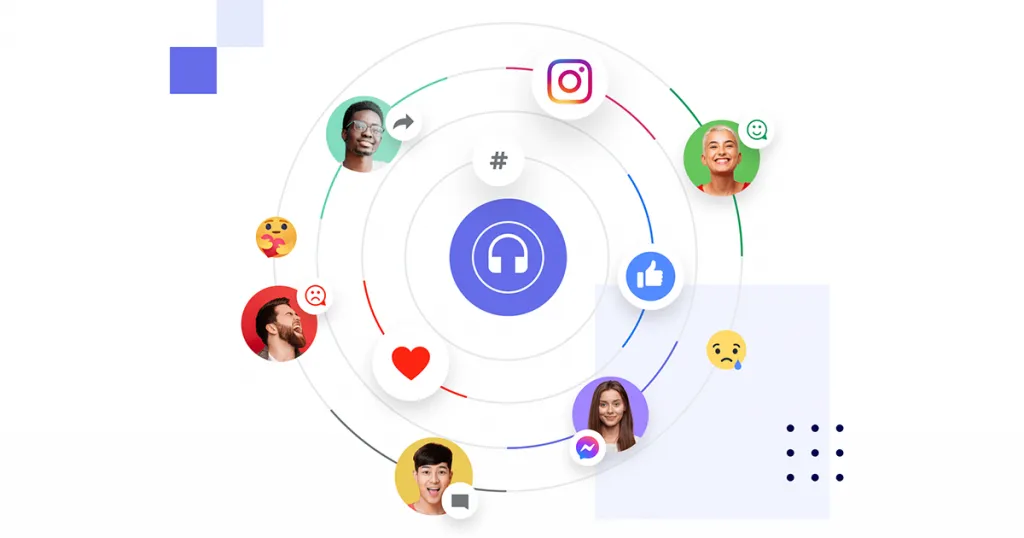
Step 4: Pick the right channels
To get meaningful insights from social listening, you need to choose the right channels as data sources based on where your audience is most active and where relevant conversations naturally happen.
Each platform offers a different type of insight. For example:
- Instagram and Facebook are great for spotting customer opinions, visual trends, and product feedback.
- X (formerly Twitter) is ideal for tracking real-time sentiment and trending topics.
- Reddit can uncover deep, honest discussions in niche communities.
- LinkedIn is useful for B2B conversations and thought leadership tracking.
- YouTube listening can reveal product mentions through titles, descriptions, and even comment sections.
- TikTok is key if your audience skews younger with trends, reviews, and viral content.
Even if your brand isn’t currently active on a platform, that doesn’t mean people aren’t talking about you there. Go where the conversations are, not just where you post. If the brand talk is spread across more than a channel you really need to bring all that data together. That way, you’ll get the full story and won’t miss any key insights.
Step 5: Analyze and interpret the data
The real value of social listening comes from analyzing what that data means and using it to make smart, strategic decisions.
To make sense of your insights, try organizing them into key categories:
- Sentiment: Are people speaking about your brand in a positive, negative, or neutral tone?
- Trends: What hashtags, topics, or phrases are gaining momentum in your industry?
- Pain points: Are there recurring complaints about your product, service, or customer experience?
- Opportunities: Are customers expressing unmet needs or gaps your competitors haven’t addressed?
Segmenting the data this way, you gain clarity on what to prioritize and where to take action.
For example, rising negative sentiment might signal a product issue, while a trending hashtag in your niche could inspire timely content.
Step 6: Take action and close the loop
Data becomes valuable only when it informs action. So what are your next steps?
- Seeing tweets about delayed shipping? -> Loop in your customer support team to address the issue and respond publicly.
- Noticing a viral hashtag related to your niche? -> Jump into the conversation with relevant, timely content.
- Spotting repeated product complaints on Reddit? -> Share the insight with your product team for improvements.
- Tracking niche sentiment shifts in forums or comments? -> Adjust your messaging to align with evolving customer values.
The more often you analyze and act on the data, the faster you’ll improve customer experience, product-market fit, and brand trust.
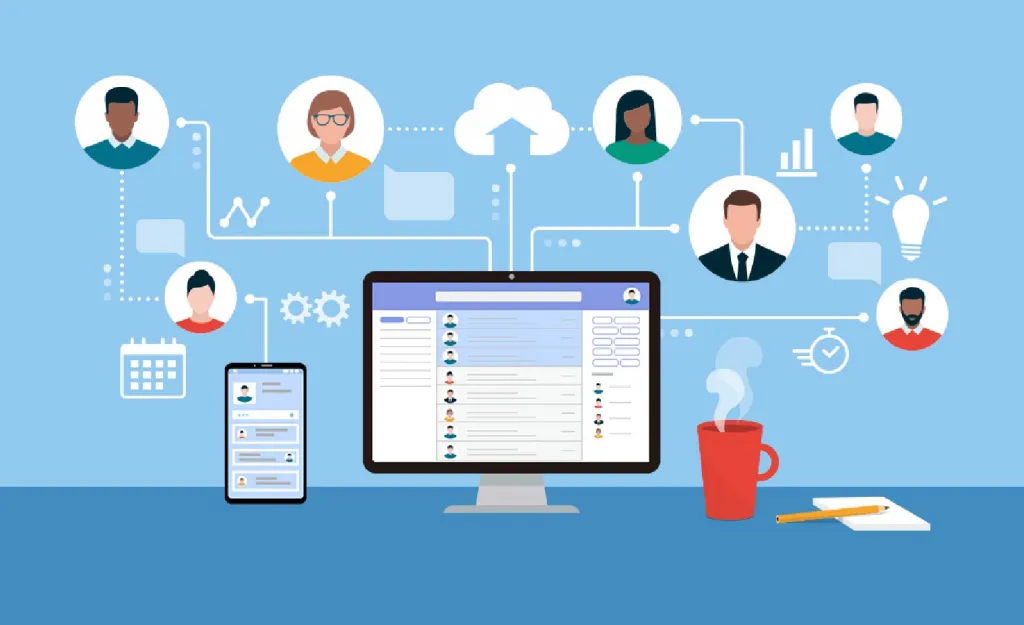
You may also like: Customer Experience Marketing: 6 Strategies for Brand Loyalty
Expert Tips to Maximize Social Listening Impact
You now have a step-by-step guide to begin your social listening journey. To further assist you, we’ve compiled 5 more practical tips that have proven effective over time.
1. Build a sentiment scoring template
Instead of just labeling mentions as positive or negative, create a scoring system to rate sentiment intensity (e.g., –5 to +5). Thus, you can track emotional shifts over time and identify spikes in excitement or frustration. A standardized template also improves consistency when sharing insights across teams.
2. Monitor competitors regularly
Keep an eye on how people talk about your competitors. This can reveal gaps in their offerings that you can fill or warn you about potential risks. Competitor listening also helps you benchmark performance and refine your messaging in real time.
3. Set alerts for influencer mentions or virality signals
Use listening tools to set up real-time alerts for high-impact mentions from influencers or sudden spikes in volume. These early signals let you engage while the moment is still hot. Speed matters, and alerts help you act fast.
4. Segment your audience by persona and region
Truly understanding your audience means listening through the lens of who they are and where they’re located. Segmenting by persona and region helps you spot differences in tone, platform use, and expectations.
5. Combine listening data with CRM and sales insights
Social listening becomes even more powerful when connected with your CRM, email, and sales tools. Thus, you can tie social sentiment to actual outcomes like conversions, churn, or upsells. It also enables more accurate targeting and messaging that reflects the full customer journey.
You may also like: Marketplace vs eCommerce Platform – Which One is Better to Start Selling?
A Multichannel Selling Tool Can Streamline Your Social Listening Efforts.
Don’t let missed messages or stock issues hurt your brand. Try a multichannel selling tool to streamline operations and stay ahead of customer feedback.
Best Social Listening Tools to Use
Here is the list of 5 tools you can discover to make your social listening strategy simplified and smarter.
1. Sprout Social
Sprout Social is a comprehensive social media management platform that combines publishing, engagement, analytics, and advanced social listening in one tool.
While users consistently praise its clean interface and in-depth reporting, many note that its pricing is on the higher end, best suited for teams that need robust collaboration and analytics features.
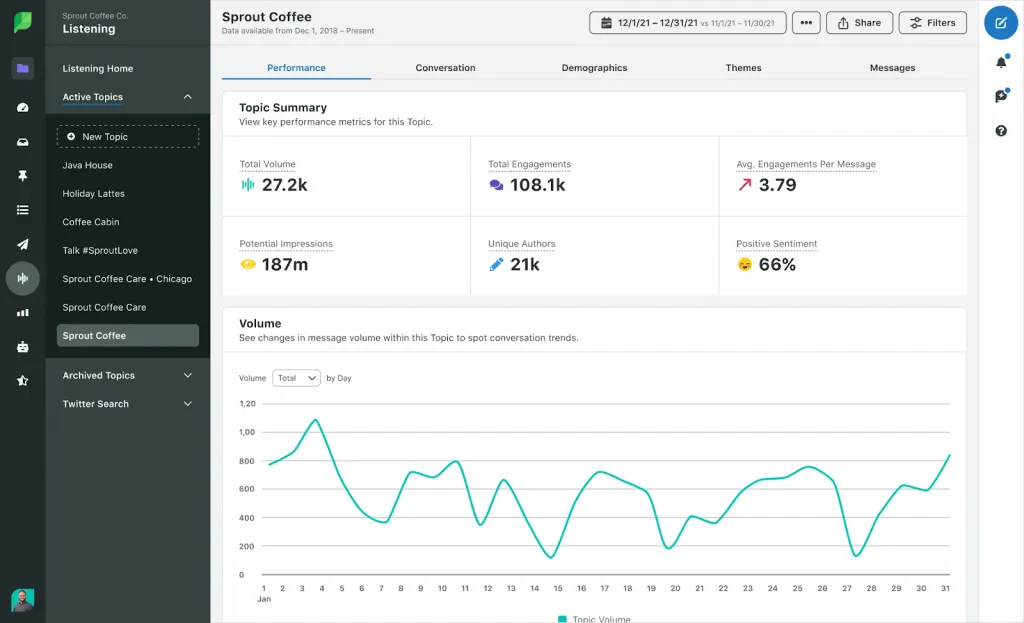
Notable features:
- AI-driven technology to uncover critical customer & competitor insights
- Smart Inbox for managing messages across platforms
- In-depth social listening insights and sentiment analysis
- Custom reports and performance tracking
- CRM-like user profiles and team collaboration tools
Best for: Mid-size to enterprise businesses looking for robust analytics, customer care tools, and team workflows.
2. HubSpot
HubSpot is a powerful CRM platform that includes social media listening within its broader Marketing Hub, making it easy to align social insights with your email campaigns, sales funnel, and customer data.
On the other hand, some mention a steep learning curve and note that unlocking full functionality often requires bundling multiple paid Hubs.
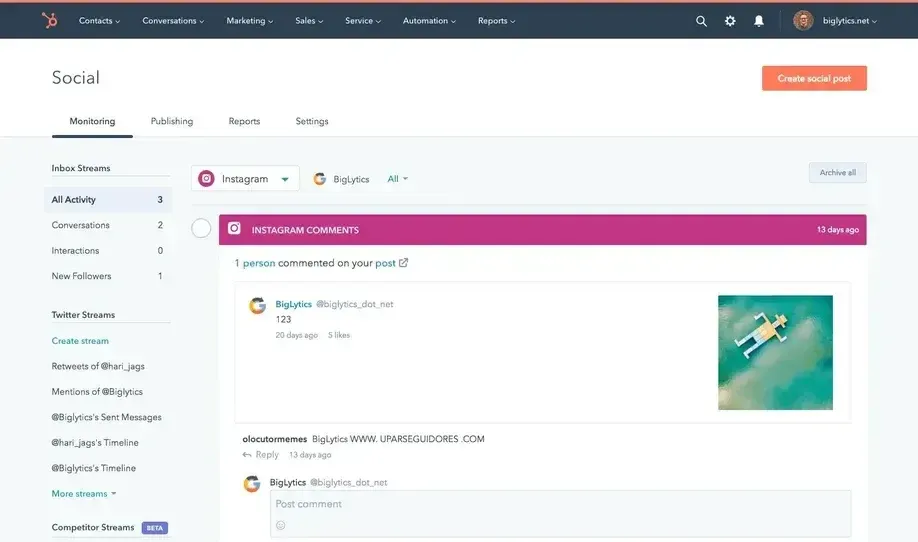
Notable features:
- Monitor brand mentions and keywords across social channels
- Schedule and publish posts directly from the platform
- Integrates social data with contact records and CRM workflows
- Built-in social listening report and analytics to measure engagement and campaign ROI
Best for: Businesses that want to connect social listening with broader marketing, sales, and CRM strategies.
3. Later
Later is a visual-first social media management tool known for its intuitive content calendar and focus on Instagram and TikTok scheduling, with basic social listening features.
It offers an affordable entry-level plan, making it popular among small businesses and creators, though some users mention limitations in social listening analytics and social media listening on lower-tier plans.
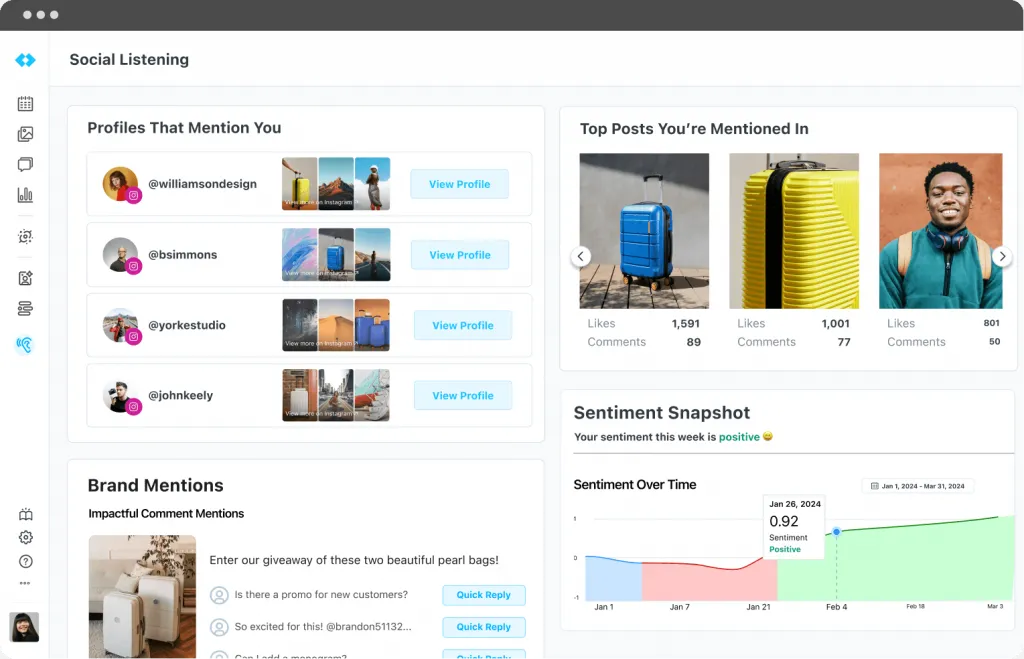
Notable features:
- Visual content planner for Instagram, TikTok, Pinterest, and more
- Hashtag suggestions and performance tracking
- Basic keyword monitoring for mentions and tags
- Linkin.bio feature to drive traffic from Instagram posts
Best for: Small businesses, creators, and social media teams focused on visual content and looking for light social listening combined with strong scheduling tools.
4. Hootsuite
Hootsuite is a widely used all-in-one social media management platform that offers publishing, engagement, analytics, and social listening capabilities. It offers tiered pricing for individuals, teams, and enterprises, though some users find advanced features locked behind higher plans.
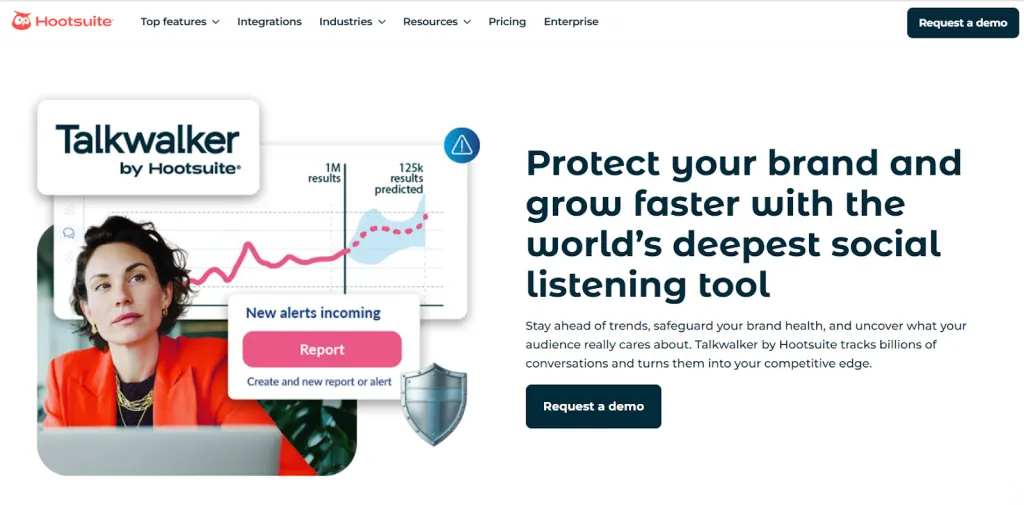
Notable features:
- Centralized dashboard for managing multiple social accounts
- Streams for monitoring keywords, hashtags, and mentions in real time
- Built-in analytics and customizable reporting
- App integrations with 150+ tools including Canva, Trello, and Google Drive
Best for: Teams and agencies that need a scalable solution for managing multiple brands or accounts across several platforms with built-in listening and scheduling.
5. Brandwatch
Brandwatch is a leading enterprise-grade consumer intelligence platform built for advanced social listening, trend forecasting, and audience analysis.
Known for its powerful AI-driven analytics, it processes billions of conversations in real time across social, news, blogs, and forums. Brandwatch is highly rated by large brands and agencies for its depth of insight, global data coverage, and customization options.
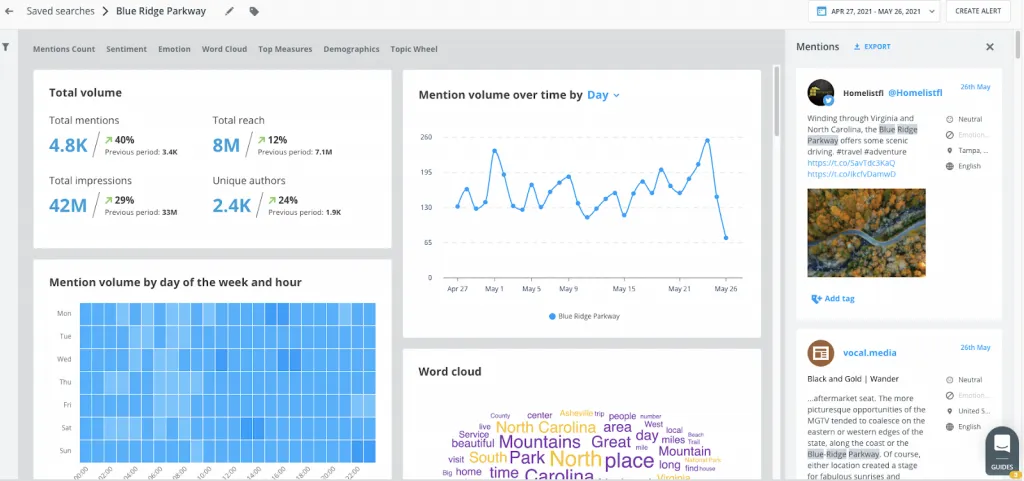
Notable features:
- AI-powered sentiment and trend analysis
- Real-time and historical social listening data tracking
- Audience segmentation and influencer identification
- Integrations with tools like Hootsuite, Google Analytics, and CRM platforms
Best for: Enterprise-level organizations needing deep insights, global data coverage, and custom reporting across multiple markets.
Social Listening Plan Checklist
1. Define objectives & scope
✅ Align listening goals with business objectives
✅ Identify key stakeholders (marketing, PR, customer service, product, execs)
✅ Set success metrics
2. Keyword & query development
✅ List core brand terms
✅ Include product/service names and abbreviations
✅ Add executive/employee names if relevant
✅ Compile competitor keywords
✅ Develop industry/topic phrases (exclude brand-specific)
✅ Create Boolean queries with operators (AND, OR, NOT, “exact phrase”)
✅ Test queries for precision vs. recall balance
3. Platform coverage
✅ Core platforms: X (Twitter), Facebook, Instagram, YouTube, TikTok
✅ Review sites: Google Reviews, Yelp, Trustpilot, G2
✅ Forums: Reddit, Quora, niche communities
✅ News & blogs: Google News, Meltwater, Mention
4. Tool selection & setup
✅ Evaluate tools
✅ Set up dashboards with real-time alerts
✅ Configure sentiment analysis (verify accuracy with sample data)
✅ Establish tagging taxonomy (topic, sentiment, urgency, department)
✅ Integrate with CRM/helpdesk (Salesforce, Zendesk)
5. Team & workflow
✅ Assign listening roles (analyst, responder, escalator)
✅ Create response protocols by scenario (crisis, complaint, praise, inquiry)
✅ Set SLA for engagement
✅ Build escalation matrix
✅ Schedule daily/weekly reporting cadence
6. Monitoring & analysis
✅ Daily: Scan high-urgency mentions, respond/escalate
✅ Weekly: Share of voice vs. competitors, sentiment trends
✅ Monthly: Deep-dive reports (themes, influencers, emerging issues)
✅ Quarterly: Goal progress review, query refinement
7. Crisis preparedness
✅ Define crisis triggers
✅ Prepare holding statements and approval workflow
✅ Set up 24/7 monitoring rotation
✅ Conduct tabletop crisis simulations
8. Reporting & taking actions
✅ Executive summary template
✅ Department-specific reports
✅ Actionable insight framework: Observation → Insight → Recommendation → Owner
✅ Track closed-loop actions
Social Listening – FAQs
What is social listening in marketing?
Social listening in marketing is the process of monitoring online conversations across social media, forums, blogs, and review sites to understand what people are saying about your brand, products, competitors, or industry. Marketers use this data to uncover trends, gauge public sentiment, improve customer experience, and create more relevant content or campaigns.
Can ChatGPT do social media listening?
ChatGPT can support social media listening efforts, but it cannot perform real-time social media listening on its own. It can help you analyze data that’s already been collected, summarize sentiment, write response templates, or generate content ideas based on trends. However, it doesn’t have direct access to live social media platforms or monitoring tools.
What is the best social media listening tool?
The best social media listening tool depends on your business size, goals, and budget. For enterprise-level insights, Brandwatch and Sprout Social are highly rated for their depth and analytics. Hootsuite is a great all-in-one option with built-in listening streams. And if you already use a CRM like HubSpot, its integrated social features make it easy to align listening with your customer data. The best choice is the one that fits your team’s workflow and helps you turn data into action.
Conclusion
Now that you’ve learned the basics of social listening, it’s time to put those insights into action. Whether you’re aiming to improve customer service, track sentiment, spot trends early, or outmaneuver your competitors, social listening gives you the data and direction to do it smarter.
The digital landscape moves fast, but when you listen closely, you stay one step ahead.
For more strategies to grow your business, connect with customers, and optimize your multichannel selling, be sure to check out the LitCommerce blog, packed with expert tips on eCommerce growth, marketplace selling, business tips & tricks, and more.

